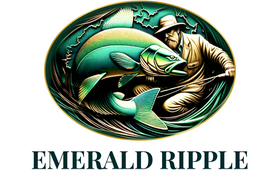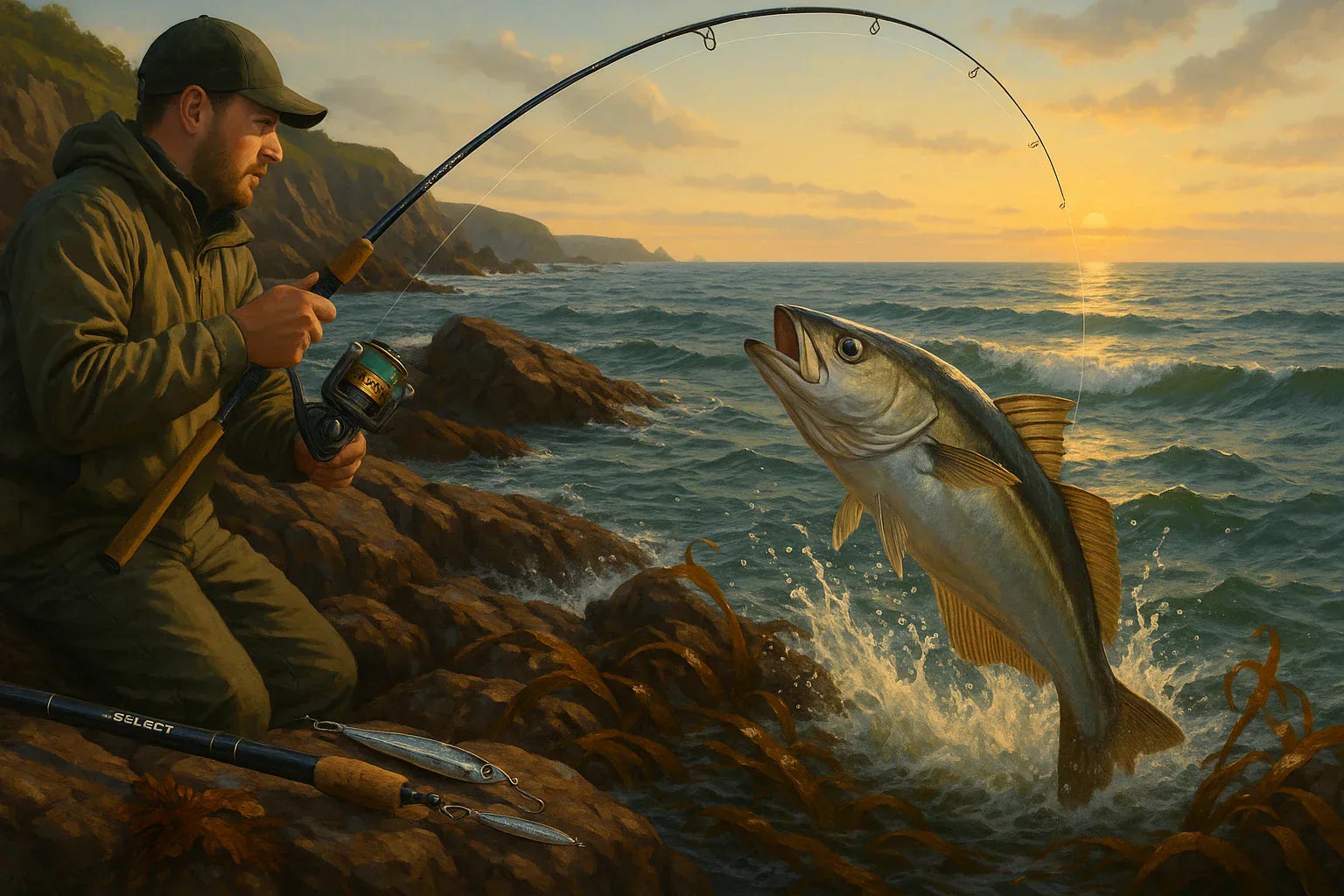POLLOCK – THE ICON OF ROCK FISHING IN IRELAND & THE UK
Pollock patrol the deep, kelp-lined gullies that carve into our Atlantic headlands. They smash a lure like a battering ram, dive for cover in seconds and can top 10 lb – more than enough muscle for any shore angler. That raw power, together with the dramatic sea-cliff scenery, is why many of us rate pollock rock-fishing above any other light-tackle sea sport.
My First Shore-Session Success
I still remember a blustery June evening on Galway Bay: 9 ft spinning rod, 30 g silver jig, braid screaming in a cross-wind. Third cast, the lure stalled mid-sink – I struck, the rod hooped over and four pounds of bronze muscle tried to bury itself in kelp. Two short runs later I beached my very first shore-caught pollock: the moment I fell in love with the species. (Kit details? See our Spinning Rods collection.)
What You’ll Learn Today
-
A complete tackle checklist – rods, reels, braid, leaders
-
How to match tide, light and lure for consistent takes
-
A quick safety crib-sheet for marks that change with every swell
-
Top product picks plus budget alternatives you can buy right now
↓ Scroll to Key Specs for the exact rod ratings I rely on.
2. Why This Matters – and the Mistakes Newcomers Make
Five Rookie Errors That Cost You Pollock
-
Too-light bass rod – any pollock over 1.5 kg (3 lb) will find kelp before you can turn it.
-
Braid under 15 lb (7 kg) – one scrape on barnacles and it’s gone.
-
Only fishing slack-high tide – the first push of the flood often outfishes high water.
-
One-colour lure box – bright pink rules in dirty water; in July’s gin-clear seas natural brown shads win.
-
Locked-down drag – give the fish one short run, then clamp down; otherwise you’ll straighten hooks.
(Made one of these mistakes? Don’t worry – we all started there.)
Spinning Rod or Sea Rod – Which Wins on the Rocks?
| Spec | 9 ft Spinning Rod | 11 ft Sea Rod |
|---|---|---|
| Casting Weight | 20–60 g | 40–100 g |
| Reach Over Kelp | ★★☆☆☆ | ★★★★☆ |
| Bite Detection | ★★★★☆ | ★★☆☆☆ |
| Fighting Power | ★★★☆☆ | ★★★★☆ |
| Best Use | Soft plastics & light jigs | Heavy metals & lumpy seas |
Verdict: I carry a fast 9 ft spinner for 25 g shads and a beefier 11 ft sea rod for 60 g metals in a swell – both live in our Rods collection.
Choosing a Safe, Productive Mark
-
Arrive one hour before low water – you’ll see gullies, snags and your escape route.
-
Look for 3 m (10 ft)+ depth within two rod-lengths; a green-brown kelp fringe is a good sign.
-
Anything above 1 m swell at 8 s period can throw rogue waves – check before you go.
3. Key Specs – Tackle That Beats Kelp and Swell
| Parameter | Recommended Range | Why It Matters |
|---|---|---|
| Rod length | 2.60-2.74 m (8'6"-9'0") | Control fish yet cast accurately from uneven rock. |
| Casting weight | 20-60 g (¾-2 oz) | Covers 25 g shads to 50 g metals. |
| Action | Fast / Extra-Fast | Positive strike, keeps contact during dives. |
| Blank | High-modulus carbon | Strength with minimal weight. |
| Guides | SiC, anti-tangle | Reduce wind knots, resist salt rash. |
Reels & Ratios
A 4000-size reel balances a 9 ft blank and holds 200 m of 0.18 mm braid. Go 5.2:1 or faster – 80-90 cm retrieval per turn clears weed fast. On a tight budget pick a 5000-8000 frame: heavier but stronger gearing.
Braid & Leader
-
Main line: PE 1.5 20 lb (9 kg) up to 35-40 lb for rough ground.
-
Leader: 30 lb (14 kg) fluorocarbon, 1 m.
-
Knot: FG or PR; practise at home, not in a gale.
4. Methods & Lures
Soft Plastics in Kelp Pockets
Slow-sinking shads worked across the gully keep you in the strike zone longer. Five-count drop, 30 cm lift, slack fall. The hit feels like weed – strike now or the fish wins. For cadence tips see Guide to Proper Lure Movement Technique for Pollock Fishing.
Metal Jigs & Slow-Pitch
In coloured water switch to 30-40 g slim metals. Thumb the spool on the drop, snap the rod, let it flutter. Pollock smash the pause. Fish almost vertical on steep faces: fewer snags, more time mid-water.
Tide, Light & Bite Windows
-
First two hours of flood – fish push up.
-
Dawn & dusk – lower light, harder hits.
-
Neaps – easier lure control.
-
90 %+ solunar windows – proven boost.
-
On-shore wind to 15 kt – brings bait, manageable swell.
5. Safety & Best Practice
Rock-Fishing Safety Checklist
-
Studded boots
-
Auto-inflating PFD
-
Buddy or texted location/time
-
Head-torch + spare battery
-
Vest knife (braid cutter)
Landing & Unhooking
Use a 3 m folding net; in a surge, a lip-grip. Barbless hooks + long-nose pliers = quick, clean release.
Weather & Swell Planning
Rule of thumb: > 1 m @ 8 s = no go. Check Windy + MagicSeaweed; two minutes’ planning beats two hours white-knuckled.
6. Gear Recommendations
Top Spinning Rods (30-40 g)
| Model | Length/CW | Why Buy |
|---|---|---|
| Golden Catch Armatur Spin | 2.74 m, 20-60 g | Fast, casts 25 g shads miles, tames 3 kg pollock. |
| Golden Catch Passion Power | 2.68 m, 15-55 g | Softer tip for single-hook shads, stout butt. |
Both rods: see full spec.
Budget Sea Rods
ZEOX Element Power 2.70 m, 160 g CW – ~€25, lobs 60 g, shrug salt. Heavier, yes, but ideal first-season stick. (cheap sea rods pollock)
Must-Have Accessories
20 lb braid + 30 lb leader, jig wallet, USB-C 400 lm head-lamp.
7. FAQ
Can I use freshwater gear?
Only if it’s rated 30 g+ and spool holds 200 m of 20 lb braid, but salt wrecks unsealed bearings fast – I snapped a favourite Skyline doing just that.
Best lure colours?
Clear water: natural browns/whites. After a storm: bright pinks/oranges. Swap after ten blank casts.
Do pollock feed at night?
Yes – especially under harbour lights two hours after dusk. Waxing moon = longer window; dark moon = cast tight to structure.
8. Conclusion & Next Steps
Gear right, fish the flood, respect the swell and never step on rock without studs and a PFD. Stick to those five rules and “maybe” sessions turn into true victories.
Next read: Guide to Proper Lure Movement Technique for Pollock Fishing – master the shad shimmy.
Ready to gear up? Compare Spinning Rods, Sea Fishing Rods or the full Rods line-up and hit the cliffs prepared.

